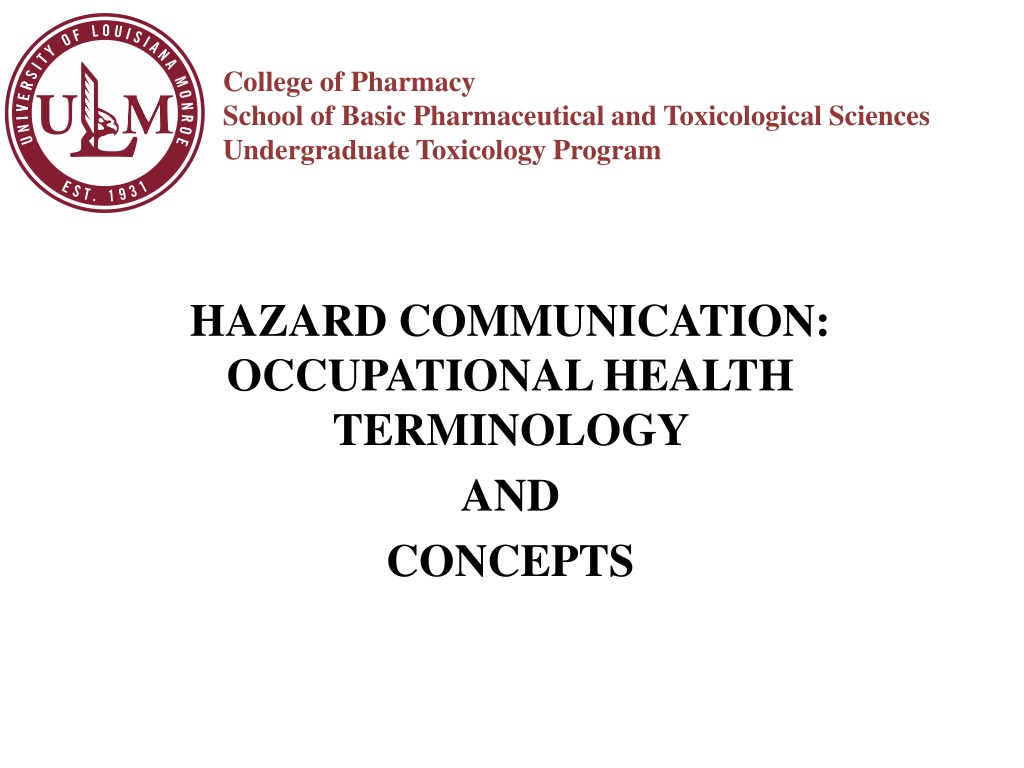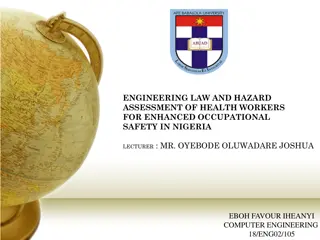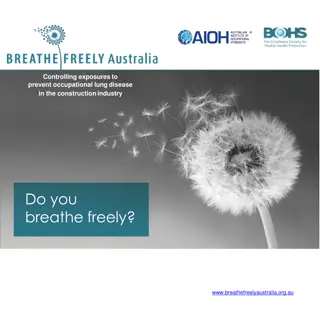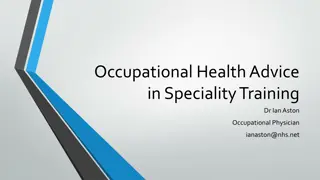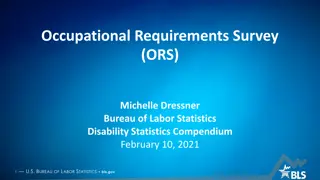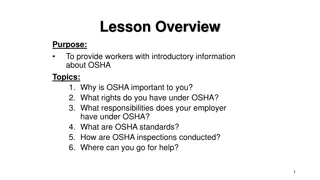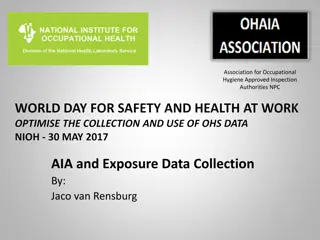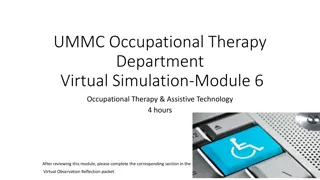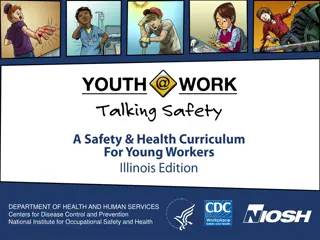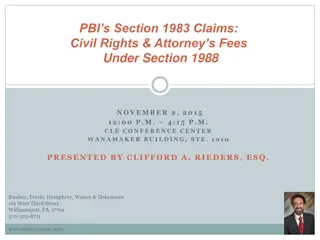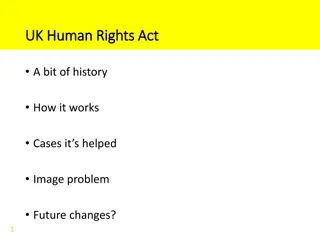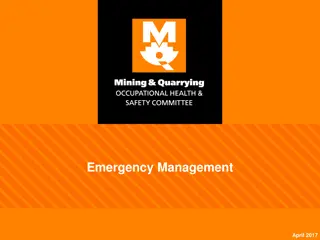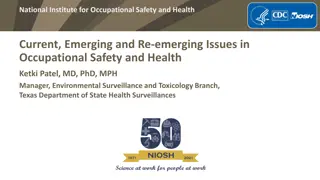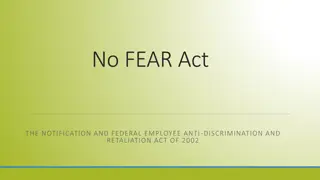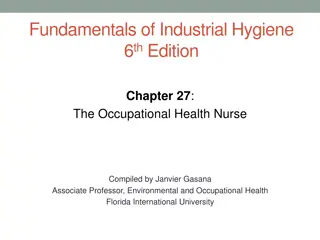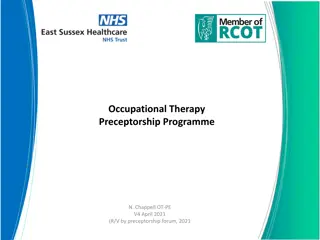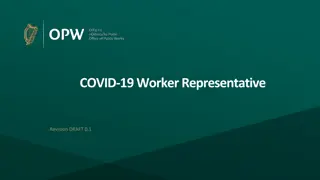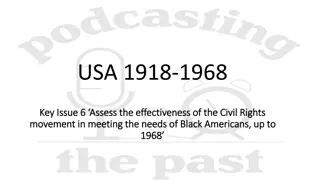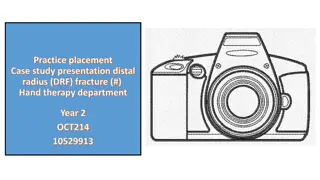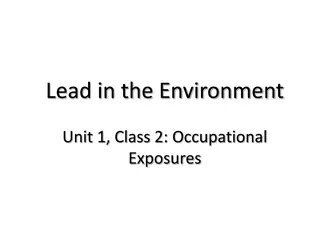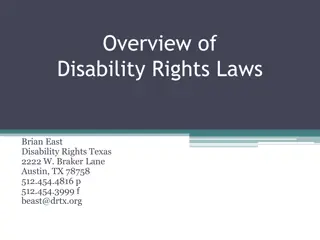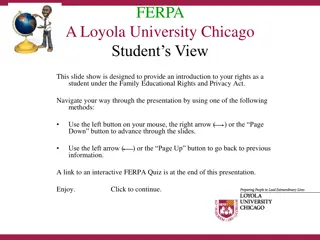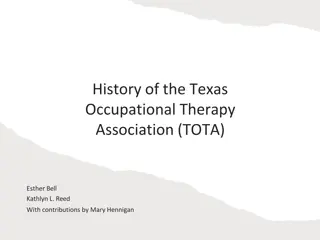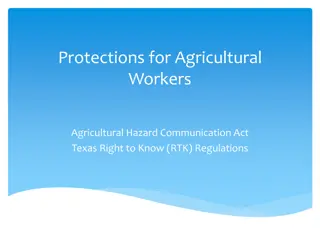Overview of Occupational Health Terminology and Worker Rights under OSH Act
This presentation covers Occupational Health Terminology, OSHA Health Standards, Hazard Communication, Toxicology, and Worker Rights under the OSH Act. It emphasizes workers' entitlement to safe conditions, the right to request workplace inspections, review records, access medical information, and training on hazard prevention. Additionally, it explores whistleblower protection and the process for filing complaints with OSHA.
Download Presentation

Please find below an Image/Link to download the presentation.
The content on the website is provided AS IS for your information and personal use only. It may not be sold, licensed, or shared on other websites without obtaining consent from the author. Download presentation by click this link. If you encounter any issues during the download, it is possible that the publisher has removed the file from their server.
E N D
Presentation Transcript
College of Pharmacy School of Basic Pharmaceutical and Toxicological Sciences Undergraduate Toxicology Program HAZARD COMMUNICATION: OCCUPATIONAL HEALTH TERMINOLOGY AND CONCEPTS
Acknowledgement United States Department of Labor Occupational Safety of Health Administration (OSHA) Susan Harwood Training Grant SH-37205-SH1 This material was produced under a grant (SH-37205-SH1) from the Occupational Safety and Health Administration, U.S. Department of Labor. It does not necessarily reflect the views or policies of the U.S. Department of Labor, nor does its mention of any trade names, commercial products, or organizations imply an endorsement by the U.S. Government. School of Basic Pharmaceutical and Toxicological Sciences Undergraduate Toxicology Program
Disclaimer The materials provided in this presentation are for information and awareness purposes. In no instances and under no conditions should they be used as a reference for compliance with the OSHA Hazard Communication standard (29CFR 1910.1200). The link to obtain a copy of the standard is provided below. OSHA Hazard Communication Standard (29 CFR 1910.1200 School of Basic Pharmaceutical and Toxicological Sciences Undergraduate Toxicology Program
Overview Introduction Worker Rights under OSH Act Purpose and Scope of Presentation Part 1: Occupational Health Terminology Review of OSHA Health Standards Brief Hazard Communication Refresher Discussion of Common Terminology Part 2: Toxicology and Toxicokenetics School of Basic Pharmaceutical and Toxicological Sciences Undergraduate Toxicology Program
Worker Rights OSH Act Occupational Safety and Health Act (OSH Act): Signed into law December 29, 1970 Entitles workers to safe and healthful conditions Provides workers with the right to: Ask OSHA to inspect their workplace Review employers records of work-related injuries and illnesses Get copies of their medical records Receive information and training about hazards and their prevention, using applicable OSHA standards. School of Basic Pharmaceutical and Toxicological Sciences Undergraduate Toxicology Program
Worker Rights OSH Act - continued Worker complaint: Workers have the right and may file a complaint against their employer with OSHA Employers may not retaliate (take unfavorable personnel actions) against an employee for being a whistleblower. For more information, please see: OSHA Whistleblowers Protection Program Whistleblower laws require that complaints be filed with OSHA within 30 calendar days following the alleged retaliation. School of Basic Pharmaceutical and Toxicological Sciences Undergraduate Toxicology Program
Purpose and Scope Purpose: Provide support information for site-specific Hazard Communication training Scope: Focus on occupational health terminology and concepts associated with toxic substances Presentation Format: Two Parts Part 1: Safety Data Sheet terminology Part 2: Principles of toxicology School of Basic Pharmaceutical and Toxicological Sciences Undergraduate Toxicology Program
Part 1: Occupational Health Terminology Introduction to OSHA standards A brief discussion of 29 CFR 1910 Hazard Communication refresher A brief refresher of 1910.1200 training requirements Discussion of the Safety Data Sheet General discussion Detailed discussion of occupational health terminology used in particular SDS sections School of Basic Pharmaceutical and Toxicological Sciences Undergraduate Toxicology Program
Introduction Occupational Safety and Health Act 29 CFR 1910 Subparts: D: Walking-Working Surfaces G: Occupational Health and Environmental Control L: Fire Protection O: Machinery and Machine Guarding Z: Toxic and Hazardous Substances School of Basic Pharmaceutical and Toxicological Sciences Undergraduate Toxicology Program
Toxic and Hazardous Substances 29 CFR 1910; Subpart Z Example standards: 1910.1001: Asbestos 1910.1025: Lead 1910.1000: Air Contaminants 1910.1200: Hazard Communication School of Basic Pharmaceutical and Toxicological Sciences Undergraduate Toxicology Program
Review of Hazard Communication Standard (29 CFR 1910.1200) Right-to-Know Law Requirement to inform workers about potential chemical hazards in the workplace Communication Methods Employer Training Container Labeling Safety Data Sheets School of Basic Pharmaceutical and Toxicological Sciences Undergraduate Toxicology Program
Globally Harmonized System Full title: Globally Harmonized System of Classification and Labeling of Chemicals Purpose: To develop global continuity in classifying and communicating chemical hazards School of Basic Pharmaceutical and Toxicological Sciences Undergraduate Toxicology Program
Safety Data Sheets Purpose Provide information regarding the hazards of a product Content organization OSHA mandated format 16 designated sections Sections important to occupational health Section 2: Hazard(s) Identification Section 4: First-Aid Measures Section 8: Exposure Control/Personal Protection Section 11: Toxicological Information School of Basic Pharmaceutical and Toxicological Sciences Undergraduate Toxicology Program
SDS Description of Sections Slide 1 Section 1: Identification Section 2: Hazard(s) Identification Section 3: Composition/Information on Ingredients Chemical Abstract Services (CAS) number Section 4: First-Aid Measures Routes of Exposure Section 5: Fire-fighting Measures School of Basic Pharmaceutical and Toxicological Sciences Undergraduate Toxicology Program
SDS Description of Sections Slide 2 Section 6: Accidental Release Measures Section 7: Handling and Storage Section 8: Exposure Controls/Personal Protection Occupational Exposure Limits Section 9: Physical and Chemical Properties Section 10: Stability and Reactivity Section 11: Toxicological Information Adverse health effects, Symptoms of exposure, etc. School of Basic Pharmaceutical and Toxicological Sciences Undergraduate Toxicology Program
SDS Description of Sections Slide 3 Section 12: Ecological Information Section 13: Disposal Considerations Section 14: Transportation Information Section 15: Regulation Information Section 16: Other Information School of Basic Pharmaceutical and Toxicological Sciences Undergraduate Toxicology Program
Safety Data Sheets Section 2: Hazard(s) Identification Target Organ System Definition.: The part of the body negatively affected by the substance Target Organ Systems: Respiratory system Nervous system Gastrointestinal (digestive) system Renal (kidney) system Hematopoietic (blood) system Hepatic (liver) system Immune system Skin School of Basic Pharmaceutical and Toxicological Sciences Undergraduate Toxicology Program
Safety Data Sheets Section 4: First Aid Measures Terminology of interest: Route of Exposure Potential Routes of Exposure: Inhalation Contact Absorption Ingestion Injection (subcutaneous) School of Basic Pharmaceutical and Toxicological Sciences Undergraduate Toxicology Program
Safety Data Sheets Section 8: Exposure Control and Personal Protection Slide 1 Engineering Controls: Ventilation Enclosure or isolation Personal Protective Equipment: Respiratory protection Skin and eye protection Exposure Limits & Recommendations: OSHA exposure limits Other exposure recommendations School of Basic Pharmaceutical and Toxicological Sciences Undergraduate Toxicology Program
Safety Data Sheets Section 8: Exposure Control and Personal Protection Slide 2 Occupational Exposure Limits (OELs) Purpose: Establish legal limits Provide recommendations Classification: Legal Limits OSHA Exposure Limit Consensus or Recommended Exposure levels ACGIH Threshold limit Value (TLV) AIHA Other School of Basic Pharmaceutical and Toxicological Sciences Undergraduate Toxicology Program
Exposure Limits - Units of Measure Slide 1 Exposure limits are expressed as a concentration of a substance in the atmosphere. Commonly used units: Parts-Per-Million (ppm) Parts-Per-Billion (ppb) Milligrams per Cubic Meter (mg/m3) Micrograms per Cubic Meter ( g/m3) Fibers Per Cubic Centimeter (f/cc) School of Basic Pharmaceutical and Toxicological Sciences Undergraduate Toxicology Program
Exposure Limits - Units of Measure Slide 2 Gasses and vapors Parts-Per-Million PPM or ppm The number of pieces out of a million total pieces $10 is 10 ppm of a million dollars Parts-Per-Billion PPB or ppb The number of pieces out of a billion total pieces $10 is 10 ppb of a billion dollars School of Basic Pharmaceutical and Toxicological Sciences Undergraduate Toxicology Program
Exposure Limits - Units of Measure Slide 3 Airborne particulates (dusts and fumes) Weight-based concentration units Milligrams per Cubic Meter: mg/m3 Weight (mg) of a substance in a volume (m3) of air Micrograms per Cubic Meter: g/m3 Weight ( g) of a substance in a volume (m3) of air School of Basic Pharmaceutical and Toxicological Sciences Undergraduate Toxicology Program
Exposure Limits - Units of Measure Slide 4 Fibers per Cubic Centimeter: f/cc Average number of fibers (typically asbestos) found in a cubic centimeter of air School of Basic Pharmaceutical and Toxicological Sciences Undergraduate Toxicology Program
OSHA Exposure Limits Law Types of OSHA Exposure Limits Permissible Exposure Limits (PELs) Action Level Short-Term Exposure Limits Ceiling Levels Location in standards Subpart Z School of Basic Pharmaceutical and Toxicological Sciences Undergraduate Toxicology Program
OSHA Exposure Limits Permissible Exposure Limit Legal exposure limit 8-hr Time-Weighted-Average Example PELs: Acetone: 1000 ppm (2400 mg/m3) Benzene: 1 ppm Total dust: 15 mg/m3 School of Basic Pharmaceutical and Toxicological Sciences Undergraduate Toxicology Program
OSHA Exposure Limits Action Levels Lower than the PEL An enforceable exposure limit Not available for all regulated substances Require some action to be taken Medical Surveillance Periodic Exposure Monitoring Employee Training School of Basic Pharmaceutical and Toxicological Sciences Undergraduate Toxicology Program
OSHA Exposure Limits Short-Term Exposure Limit and Ceiling Value Short-Term Exposure Limit: STEL 15-min TWA Ceiling Value Instantaneous exposure School of Basic Pharmaceutical and Toxicological Sciences Undergraduate Toxicology Program
OSHA Exposure Limits Example Formaldehyde (29 CFR 1910.1048) PLEASE NOTE: Use For Example Only PEL: 0.75 ppm, as 8-hr TWA Action Level: 0.5 ppm, as 8-hr TWA Periodic monitoring Medical Surveillance STEL: 2 ppm, as 15-minute TWA Medical Surveillance Mandatory Training: 0.1 ppm, any exposure School of Basic Pharmaceutical and Toxicological Sciences Undergraduate Toxicology Program
Non-OSHA Occupational Exposure Recommendations Purpose: Provide guidelines Sources: American Conference of Governmental Industrial Hygienist (ACGIH) Threshold Limit Values (TLV) American Industrial Hygiene Association (AIHA) Workplace Environmental Exposure Levels (WEEL) Manufacturers School of Basic Pharmaceutical and Toxicological Sciences Undergraduate Toxicology Program
ACGIH TLV Threshold Limit Values A.k.a.: TLV Recommendation, not law Consensus standards 8-hr Time-Weighted-Averages Short-Term Exposure Limits School of Basic Pharmaceutical and Toxicological Sciences Undergraduate Toxicology Program
Safety Data Sheet Section 11: Toxicological Information Covers numerous health topics Route of exposure Potential health effects Delayed, immediate, and/or chronic effects Short and long-term exposures Measures of toxicity Lethal Dose 50 (LD-50), etc. Symptoms of exposure Carcinogen status School of Basic Pharmaceutical and Toxicological Sciences Undergraduate Toxicology Program
Routes of Exposure How can chemicals from the workplace enter workers bodies? Workplace routes of exposure Inhalation Contact Absorption Ingestion Injection School of Basic Pharmaceutical and Toxicological Sciences Undergraduate Toxicology Program
Potential Health Effects Time for effect onset: Delayed effects Immediate effects Chronic effects Exposure times: Short-term (acute) exposure Long-term (chronic) exposure School of Basic Pharmaceutical and Toxicological Sciences Undergraduate Toxicology Program
Acute Health Effects Def.: Adverse health effects that occur quickly after a significant exposure Significance of adverse health effect: Insignificant or minor Serious but treatable Death or life altering outcomes School of Basic Pharmaceutical and Toxicological Sciences Undergraduate Toxicology Program
Chronic Health Hazards Def.: An adverse health effect resulting from a long-term exposure to a substance Significance of exposure: Permanent adverse conditions: Reduced lung capacities Hypersensitivity Chemically-induced asthma Serious Illnesses: Cancers Significant pneumoconiosis (New-Mo-Cone-Knee-O-Sis) School of Basic Pharmaceutical and Toxicological Sciences Undergraduate Toxicology Program
Measures of Toxicity Terminology often associated with toxicity studies Lethal Dose 50 (LD-50) Evaluate lethality Immediately Dangerous to Life and Health Dangerous atmospheric concentrations School of Basic Pharmaceutical and Toxicological Sciences Undergraduate Toxicology Program
Symptoms of Exposure Indication of an exposure Examples: Eye, nose, throat, mucus membrane irritation Nausea, dizziness, light headedness Metallic taste in mouth Tingling of lips or mouth Unconsciousness Tremors Others School of Basic Pharmaceutical and Toxicological Sciences Undergraduate Toxicology Program
Carcinogen Status Slide 1 OSHA reporting requirement: 0.1% or greater 29 CFR 1910.1003: 13 Carcinogens Carcinogen Designation: International Agency for Research on Cancer American Conference of Governmental Industrial Hygienist School of Basic Pharmaceutical and Toxicological Sciences Undergraduate Toxicology Program
Carcinogen Status Slide 2 ACGIH IARC A1: Confirmed human carcinogen A2: Suspected human carcinogen A3: Animal carcinogen A4: Not classified as a human carcinogen A5: Not suspected as a human carcinogen Group 1: Carcinogenic to Humans Group 2A: Probably Carcinogenic to Humans Group 2B: Possibly Carcinogenic to Humans Group 3: Not Classifiable as to its Carcinogenicity to Humans Group 4: Probably not Carcinogenic to Humans School of Basic Pharmaceutical and Toxicological Sciences Undergraduate Toxicology Program
Part 2 Toxicology Topics to be discussed: Introduction to Toxicology Dose-Response relationship Toxicokinetics Definition Routes of exposure Distribution Elimination School of Basic Pharmaceutical and Toxicological Sciences Undergraduate Toxicology Program
Toxicology What is Toxicology? Def.: The study of the adverse effects of substances on living organisms and the environment Paracelsus Father of Toxicology All things are poisons The dose determines the poison School of Basic Pharmaceutical and Toxicological Sciences Undergraduate Toxicology Program
Dose-Response Relationship Dose Def.: The amount or concentration of a substance or stimulus received Response: The change caused by the substance, at the given dose School of Basic Pharmaceutical and Toxicological Sciences Undergraduate Toxicology Program
Dose-Response Curve Example 1 Response Dose School of Basic Pharmaceutical and Toxicological Sciences Undergraduate Toxicology Program
Dose-Response Curve Example 2 Basic Dose-Response Curve Response Dose School of Basic Pharmaceutical and Toxicological Sciences Undergraduate Toxicology Program
Toxicokinetics What is Toxicokinetics? Def.: The study of what happens to a chemical when it enters the body Including: Absorption processes Distribution through the body Biotransformation (metabolism of the substance) Excretion School of Basic Pharmaceutical and Toxicological Sciences Undergraduate Toxicology Program
Routes of Exposure Slide 1 How can chemicals from the workplace enter workers bodies? Workplace routes of exposure Inhalation Contact Absorption Ingestion Injection Multiple routes of exposure School of Basic Pharmaceutical and Toxicological Sciences Undergraduate Toxicology Program
Routes of Exposure Slide 2 Inhalation: Primary exposure route for air contaminants Substance enters the body through the respiratory system Adverse effect may occur: Respiratory system Any other target organ system School of Basic Pharmaceutical and Toxicological Sciences Undergraduate Toxicology Program
Routes of Exposure Slide 3 Contact: Generally associated with materials that cause damage to the skin Primary concern for exposure to corrosives Acids and bases Contact may lead to other routes of exposure Absorption Ingestion School of Basic Pharmaceutical and Toxicological Sciences Undergraduate Toxicology Program
Routes of Exposure Slide 4 Absorption Skin absorption Generally, associated with chemicals being absorbed through the skin Epidermis Appendages Damaged skin Examples: Carbon Tetrachloride Pesticides Sarin School of Basic Pharmaceutical and Toxicological Sciences Undergraduate Toxicology Program
